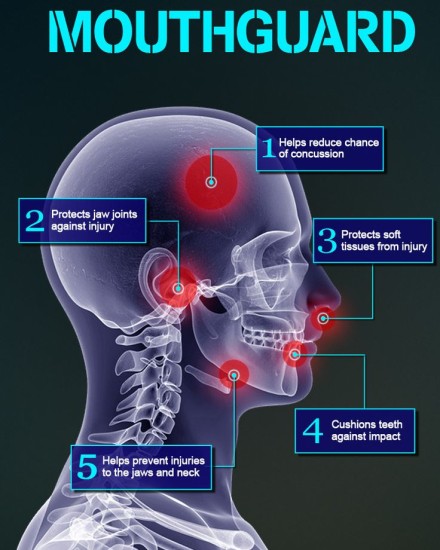One of the most important parts of any uniform
Save Face… Know the Stats
- An athlete is 60 times more likely to suffer harm to the teeth when not wearing a mouthguard. American Dental Association
- It is estimated that mouthguards prevent more than 200,000 injuries each year. Academy of General Dentistry
- Sports-related dental injuries account for more than 600,000 emergency room visits each year. U.S. Centers for Disease Control
- Victims of knocked out teeth who do not have a tooth properly preserved or replanted may face lifetime dental costs of $10,000 to $20,000 per tooth. National Youth Sports Foundation for Safety
Are custom-made guards really better?
Custom-made mouth protectors: According to Dr. Ray Padilla, incoming President of the Academy of Sports Dentistry, the best mouthguard (based on research evidence), remains one that is custom designed and made by a dental professional with the athlete’s individual needs taken into account. It allows the dentist to address questions at a “pre-season” screening or dental examination. The age of a child or adolescent athlete and the possibility of providing space for erupting (growing) teeth and jaws, can be accommodated with a custom-made guard. Even the very best over the counter product cannot insure quality and effectiveness.
Custom mouth guards are made from exact and precise models of an individual’s own teeth; are made of resilient and tear resistant materials ensuring a proper fit; are comfortable, easy to clean, and do not restrict breathing. A properly fitted mouthguard must be protective, comfortable, resilient, tear resistant, odorless, tasteless, not bulky and have excellent retention, fit, and sufficient thickness in critical areas.
There are two types of custom mouthguards, the outdated Vacuum Mouthguard and the modern Pressure Laminated Mouthguard. A “thermoplastic” material (thermo-heat, plastic-moldable), usually EVA is adapted over the model with a vacuum machine; the mouthguard is then trimmed and polished to allow for proper tooth and gum adaptation. All back teeth should be covered and muscle attachments not impinged upon.
More recent studies suggest that the use of a more accurate pressure “thermo-forming” machine for the fabrication of multiple layered or laboratory pressure laminated (layered) mouthguard, are much more preferable to the single layer vacuum mouthguards. Laminated guards should last for at least 2 years for an adult with normal use. Each athlete should be evaluated individually for thickness and design to promote comfort and sufficient protection. The thicker materials (3-4mm) are not bulky and uncomfortable, but are more effective in absorbing impact energy. The thinner materials show marked deformation at the site of impact. Costs vary but are generally in $100 to $200 range.
How should a mouthguard be looked after?
According to a study in General Dentistry, “Everything that a microorganism needs to survive, including food and water, can be found in a mouthguard. Like other dental appliances such as dentures and retainers, mouthguards appear solid but they are very porous, like a sponge, and with use, microorganisms invade these pores.” Therefore:
- Rinse before and after each use or brush with a toothbrush and toothpaste.
- Clean the mouthguard after use in cold, soapy water or mouthwash and rinse thoroughly.
- Transport the mouthguard in a sturdy container that has vents.
- Make sure not to leave the mouthguard in the sun or in hot water.
- Check for wear and replace the mouthguard when necessary.

